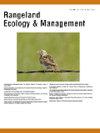建立耕地转换风险模型,以扩大核心沙棘灌木牧场避免损失的规模
IF 2.4
3区 环境科学与生态学
Q2 ECOLOGY
引用次数: 0
摘要
预计耕地将继续从大平原向西迁移,进入美国本土现存最完整的生物群落--鼠尾草(蒿属)生物群落。然而,人们对耕地向鼠尾草生态系统转化的程度和风险,以及地役权在避免生态功能丧失方面的景观效益知之甚少。因此,我们的目标是:1)量化鼠尾草生物群落的耕地面积;2)确定哪些地方最优质的鼠尾草牧场最有可能在未来被耕地转化;3)估算保护地役权对邻近公共土地的生态效益。我们发现,在鼠尾草生物群落中,耕地面积达 1,440 万公顷,在大鼠尾草(Centrocercus urophasianus)的历史分布区中,耕地面积达 1,620 万公顷,并且呈区域性聚集。我们的空间风险模型确定有 370 万公顷的优质鼠尾草牧场需要保护,以免被耕地转化,风险较高的地区集中在区域内(如大平原北部)。我们对以往耕地转换损失的估计表明,大约 80% 面临风险的优质鼠尾草群落已经被翻耕。我们风险模型的空间数据和在线地图可作为规划工具公开使用,用于确定保护和恢复行动的优先次序,以支持 "鼠尾草保护设计 "框架。通过对蒙大拿州中北部的案例研究,我们证明了私人土地地役权对于保护核心鼠茅草区(CSA)至关重要。研究发现,这些地役权间接保护的 CSA 面积是地役权本身面积的 3.6 倍。值得注意的是,这种保护效益的很大一部分(约 80%)发生在地役权附近的公共土地上。我们的研究结果表明,私人土地保护投资与附近公共土地的受益结果之间存在明确的联系,集中、永久的保护工作可将生态系统功能扩展到地役权之外。本文章由计算机程序翻译,如有差异,请以英文原文为准。
Modeling Cropland Conversion Risk to Scale-Up Averted Loss of Core Sagebrush Rangelands
Cropland conversion is anticipated to continue westward from the Great Plains into the sagebrush (Artemisia spp.) biome – the most intact biome remaining in the conterminous United States. However, relatively little is known about the extent and risk of cropland conversion to sagebrush ecosystems and the landscape scale benefits of easements in averting loss of ecological function. Therefore, our goals were to 1) quantify the cropland area of the sagebrush biome, 2) identify where the highest quality sagebrush rangelands are most at risk to future cropland conversion, and 3) estimate the ecological benefits of conservation easements to adjacent public lands. We found that croplands span 14.4 million ha in the sagebrush biome, 16.2 million ha in the historic range of the greater sage-grouse (Centrocercus urophasianus), and are clustered regionally. Our spatial risk model identified 3.7 million ha of high-quality sagebrush rangelands in need of conservation protections from cropland conversion, with higher risk areas clustered regionally (e.g., Northern Great Plains). Our estimates of previous losses to cropland conversion indicated that roughly 80% of at-risk high-quality sagebrush communities have already been tilled. Spatial data and online maps of our risk model are publicly available as planning tools for prioritizing conservation and restoration actions in support of the Sagebrush Conservation Design framework. Using a case study from north-central Montana, we demonstrated that private land easements are crucial for the preservation of Core Sagebrush Areas (CSAs). These easements were found to indirectly preserve an area of CSAs that is 3.6 times larger than the easements themselves. Notably, a significant portion of this conservation benefit—approximately 80%—occurred on public lands adjacent to the easements. Our findings establish a clear connection between investments in private land conservation and beneficial outcomes on nearby public lands, and that focused, permanent protection efforts can extend ecosystem function beyond easements.
求助全文
通过发布文献求助,成功后即可免费获取论文全文。
去求助
来源期刊

Rangeland Ecology & Management
农林科学-环境科学
CiteScore
4.60
自引率
13.00%
发文量
87
审稿时长
12-24 weeks
期刊介绍:
Rangeland Ecology & Management publishes all topics-including ecology, management, socioeconomic and policy-pertaining to global rangelands. The journal''s mission is to inform academics, ecosystem managers and policy makers of science-based information to promote sound rangeland stewardship. Author submissions are published in five manuscript categories: original research papers, high-profile forum topics, concept syntheses, as well as research and technical notes.
Rangelands represent approximately 50% of the Earth''s land area and provision multiple ecosystem services for large human populations. This expansive and diverse land area functions as coupled human-ecological systems. Knowledge of both social and biophysical system components and their interactions represent the foundation for informed rangeland stewardship. Rangeland Ecology & Management uniquely integrates information from multiple system components to address current and pending challenges confronting global rangelands.
 求助内容:
求助内容: 应助结果提醒方式:
应助结果提醒方式:


